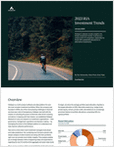The greatest risk to boomers’ retirement income may not be the impact of sweeping changes to Social Security or a prolonged market downturn. It is the possibility of a long term care need.
This risk directly impacts the security of the boomers’ entire portfolios.
Self-insuring for LTC costs helps expose the clients’ retirement income to its greatest risk. However, attractive protection options are available, particularly for mass affluent and affluent clientele, via use of LTC riders with universal life policies. Let’s examine the options.
o Traditional LTC insurance, or self-insuring with cash reserve
Traditional LTC insurance is one option. For many boomers, though, this may be unappealing; in fact, despite years of product availability and ever-growing life expectancy numbers, only a small percent of the market for LTC insurance has been penetrated. One explanation is fairly simple: Boomers often view traditional LTC premiums as expensive “sunk costs”–i.e., if the insurance is never needed, the assets used to fund the premiums are lost.
So, the majority of boomers are, by definition, self-insuring, whether they know it or not. Some do nothing. Many others actively self-insure by setting aside an emergency fund, expecting this “cash reserve” will provide liquid assets in event of an LTC need. However, with LTC costs rising each year, this presents a real financial challenge, even for affluent Americans. It can be the greatest risk to retirement income security. Consider: In 2004 alone, an average annual cost of nursing home care was $70,000, according to the Congressional Budget Office.
o Protect portfolio, leverage cash reserve
When an LTC need arises, boomers won’t immediately start liquidating investments, valuable assets or selling their homes. The first thing they’ll do is tap cash reserves. But even if the cash reserve is as significant as $150,000, it’s easy to see how quickly that asset could be depleted by LTC costs. Then, the whole portfolio becomes at risk if additional money is needed and assets that could have been used for supplemental retirement income must be liquidated.
By taking just a portion of the cash reserves, the advisor can reallocate it to a single-premium purchase of a “hybrid” policy that links the benefits of universal life insurance and an LTC rider. This can help the client receive up to five times or more of initial premium in the form of tax-qualified reimbursement for covered LTC expenses. If the policy has a lifetime return of premium (ROP) feature, too, this allows clients to retain control of the asset, via the ability to reclaim full premium at any point (potential tax implications may apply). This creates reallocation of cash reserve, not a straight expense as with traditional LTC.
Advisors therefore have a unique opportunity to help boomers leverage a portion of their cash reserves for potential LTC purposes while liberating the remaining assets for retirement income use. Advisors can use the hybrid to help boomers keep control of their assets, maintain flexibility and maximize use of assets while providing greater safety and security for retirement income assets.
Let’s look at some numbers to see how this could work: A 65-year-old female has a portfolio including a home, investments and life insurance. She is self-insuring for LTC with a cash reserve of $300,000. In lieu of “self-insuring,” her advisor encourages her to consider an alternative strategy: move $200,000 of the cash reserve to a hybrid UL/LTC with ROP, making a single-premium payment of $200,000.








 May 14, 2006 at 04:00 PM
May 14, 2006 at 04:00 PM










